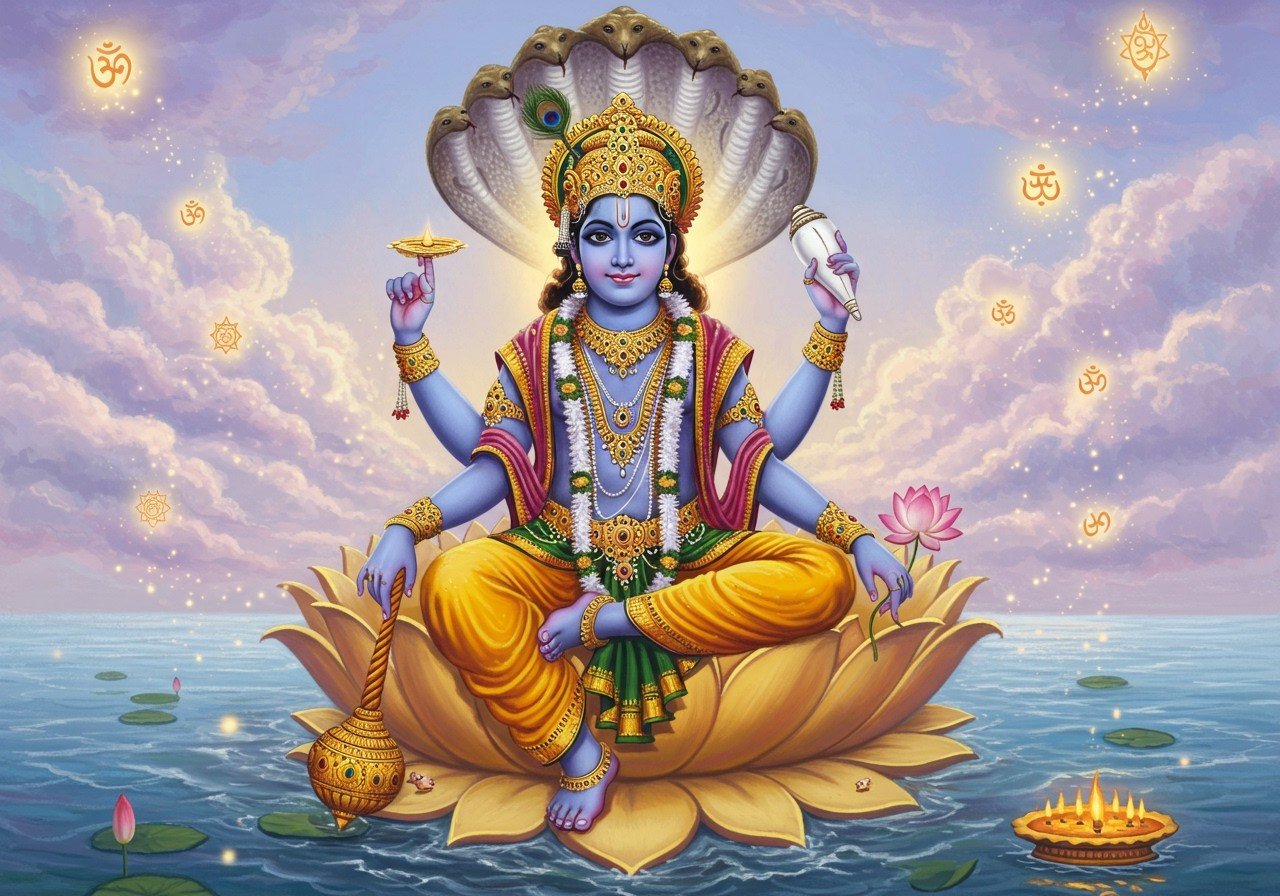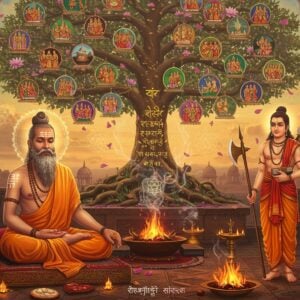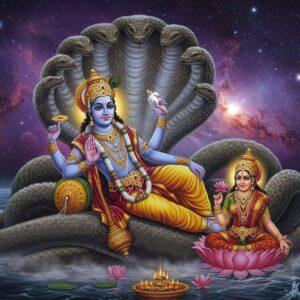
Lord Vishnu’s iconography offers a captivating glimpse into the rich tapestry of Hindu mythology. His depictions are not merely artistic expressions; they are imbued with profound spiritual meaning, reflecting core Hindu beliefs and values. From ancient sculptures to contemporary art, Vishnu’s image has evolved while retaining its sacred role in devotion. Let’s delve into the profound symbolism that surrounds Lord Vishnu.
Deciphering the Divine Form of Lord Vishnu
Vishnu’s appearance is typically portrayed with a serene and majestic demeanor, symbolizing peace and divinity. His dark blue complexion, reminiscent of the infinite sky and ocean, signifies the vastness of the universe he pervades. Vishnu’s four arms are not merely aesthetic; they represent his dominion over the cosmos and his multifaceted nature.
- The ornate crown and jewelry he adorns highlight his status as the preserver of the universe, symbolizing prosperity and abundance. These elements combine to convey his divine nature and crucial role in maintaining cosmic balance.
- Vishnu is often shown holding symbolic objects in each of his four hands, each object carrying a deep spiritual meaning. These objects represent different aspects of his divine power and his role in the universe. They are the conch shell (Shankha), the discus (Chakra), the mace (Gada), and the lotus flower (Padma). Understanding the symbolism of these objects offers further insight into Vishnu’s multifaceted nature.
If you are looking for authentic idols of Vishnu, visit our store poojn.in. We offer a wide variety of sizes and materials to suit your needs. You’ll find everything you need to create a beautiful and sacred space for your deity.
Unveiling the Significance of Vishnu’s Attributes
Each item held by Lord Vishnu carries profound meaning within Hindu mythology. These attributes represent vital aspects of the universe and his role within it. The conch shell (Shankha), specifically the Panchajanya, symbolizes the primordial sound of creation, the resonance of divine knowledge spreading throughout existence. The conch’s sound is believed to dispel negativity and usher in auspiciousness, embodying strength, authority, and sovereignty. Learn more about Lord Garuda, Vishnu’s mount.
- The discus (Chakra), known as the Sudarshana Chakra, embodies the sharpness of the mind and the power to vanquish evil. It signifies the eradication of disorder, representing strength, knowledge, and the preservation of cosmic harmony. This divine weapon serves as a constant reminder of Vishnu’s commitment to upholding righteousness.
- The mace (Gada), called Kaumodaki, symbolizes the strength required to protect dharma (righteousness). It embodies authority and courage, representing the power of knowledge to overcome life’s obstacles. The mace serves as a powerful reminder of Vishnu’s role as the protector and preserver.
Looking for high-quality puja items for Lord Vishnu? Poojn.in offers a wide selection of authentic products, from incense sticks to Shaligram stones, delivered right to your doorstep.
The lotus flower (Padma) embodies purity, beauty, and the journey towards spiritual liberation. It stands for divine beauty and the blossoming of the soul. The lotus, rising from murky waters to bloom in pristine beauty, also signifies creation, fertility, transcendence, and divine grace.
Decoding the Meaning Behind Vishnu’s Poses
Vishnu’s poses, or ‘mudras,’ convey deep spiritual messages to devotees. The Abhaya Mudra, a gesture of reassurance and protection, symbolizes fearlessness and offers comfort to those seeking refuge in the divine. It epitomizes Vishnu’s protective nature and his unwavering support for his devotees.
- The Varada Mudra, a gesture of benevolence, symbolizes the granting of boons and blessings. This pose highlights Vishnu’s boundless compassion and his willingness to bestow grace upon his followers. It reflects his role as a benevolent deity who responds to the prayers of his devotees.
- Vishnu is often depicted reclining on the serpent Ananta Shesha. This iconic pose represents the cyclical nature of time and the delicate balance between creation and destruction. It symbolizes the endless cycle of life, death, and rebirth, emphasizing Vishnu’s eternal presence throughout these cosmic shifts.
Vishnu’s Avatars: Exploring Their Unique Iconography
Lord Vishnu manifests in various avatars, each embodying specific roles within the cosmic order. The ten principal avatars, known as the Dashavatara, showcase distinct attributes and forms. These avatars highlight Vishnu’s adaptability in addressing the ever-changing challenges to maintain cosmic balance. Explore the significance of Yameshwar temples in India.
Popular avatars like Rama, Krishna, and Narasimha have unique depictions in art and culture, each reflecting their specific roles and characteristics. Krishna’s playful demeanor embodies divine love and joy, while Rama’s noble stance represents duty and honor. Each avatar’s iconography reflects the specific qualities they embody and the lessons they impart.
The Cultural and Religious Significance of Vishnu’s Iconography
Vishnu’s iconography plays a central role in Hindu worship and rituals. His depictions serve as focal points in temples and sacred spaces, aiding in devotion and meditation. They serve as visual reminders of his divine presence and inspire devotees to connect with him on a deeper level. Discover Vishnu temples in Bhubaneswar.
Vishnu’s imagery permeates Indian art, dance, and literature, reflecting its enduring cultural impact. His symbols guide devotees towards spiritual awakening and a deeper understanding of Hindu philosophy. The rich symbolism associated with Vishnu’s iconography continues to inspire and guide devotees on their spiritual journeys.
How Poojn.in Can Enhance Your Connection with Lord Vishnu
At Poojn.in, India’s leading provider of spiritual and ritualistic items, we offer a wide selection of authentic puja items specifically for worshipping Lord Vishnu. Our carefully curated collection helps you maintain the sacred traditions of Vishnu puja with ease and reverence.
Essential Items for Vishnu Puja Available at Poojn.in:
- Pure copper yantras for focused Lord Vishnu worship, enhancing the energy of your sacred space.
- Tulsi malas crafted from authentic holy basil beads, connecting you to the divine energy of Vishnu.
- Vishnu aarti essentials, including cotton wicks and pure ghee, for performing traditional aarti rituals.
- Shaligram stones, considered sacred representations of Vishnu, for establishing a powerful presence in your home temple.
- Yellow cloth and yellow flowers, traditionally associated with Vishnu, for creating a vibrant and auspicious atmosphere during puja.
- Panchaamrit ingredients for abhishekam, a sacred bathing ritual for deities.
Why Choose Poojn.in for Your Vishnu Puja Needs?
- 100% Authentic and Traditional Items: We source our products with utmost care, ensuring their authenticity and adherence to traditional standards.
- Convenient Delivery: We deliver your chosen items directly to your doorstep, saving you time and effort.
- Expert Guidance: Our knowledgeable team is available to assist you in selecting the right items for your specific puja needs.
- Quality Assurance: We partner with verified sellers and conduct thorough quality checks to guarantee the highest standards.
- Secure Payments: Our online payment gateway is secure and reliable, ensuring a safe and smooth transaction.
- Pan-India Shipping: We deliver across India, making our products accessible to devotees nationwide.
To order your Vishnu puja items:
Visit: www.poojn.in
Call: 03369029784
WhatsApp: 9476142738
Our dedicated team is ready to assist you in selecting the perfect items for your Vishnu puja. All products are carefully packaged to maintain their purity and sanctity during transit.
Note: Product availability may vary. Please check our website for the latest stock and pricing information.
Conclusion: Embracing the Enduring Wisdom of Vishnu’s Iconography
Exploring Lord Vishnu’s iconography reveals a profound tapestry of symbols and meanings deeply woven into Hindu traditions. Each attribute, pose, and avatar serves as a potent reminder of his divine roles in the universe, embodying values of strength, knowledge, protection, and spiritual purity. These symbols guide devotees on their spiritual journeys, offering solace, inspiration, and a deeper connection to the divine.
Vishnu’s imagery holds a revered place in temples and in the hearts of devotees, encouraging reflection and devotion. His presence bridges the past and the present, illuminating timeless principles that uplift and inspire. By understanding the nuances of Vishnu’s iconography, one gains a richer appreciation for Hindu culture and its enduring wisdom. May these symbols continue to enlighten and guide us, reminding us of Lord Vishnu’s eternal presence and blessings in our lives.
Visit our blog for more insightful articles on Hindu deities and rituals.
Frequently Asked Questions about Lord Vishnu’s Iconography
What are the key characteristics of Lord Vishnu’s appearance? Lord Vishnu is typically depicted with a serene and peaceful expression, often adorned with a blue complexion, symbolizing the infinite expanse of the universe. His four arms are a prominent feature, each holding a symbolic object.
What is the significance of the objects held by Lord Vishnu? Lord Vishnu holds a conch shell (Shankha), a discus (Chakra), a lotus flower (Padma), and a mace (Gada) in his four hands. These objects are not mere adornments; they carry deep symbolic meaning within Hindu mythology, representing different aspects of his divine power and cosmic role.
Why is blue associated with Lord Vishnu? Lord Vishnu’s blue complexion symbolizes the vastness and depth of the universe, much like the endless sky and the deep ocean. This color signifies his eternal and all-pervading nature, reflecting his cosmic presence.
What does the conch shell represent in Vishnu’s iconography? The conch shell, or Shankha, is more than just a beautiful object; it symbolizes the divine sound ‘Om’ and is believed to dispel negativity and usher in auspiciousness. It embodies purity, strength, and the spread of divine knowledge.
What is the symbolism of the discus in Lord Vishnu’s hands? The discus, or Chakra, represents the mind’s sharpness and the power to overcome evil. It is a symbol of protection and divine power, used to destroy negativity and preserve righteousness, maintaining cosmic order.
Why does Lord Vishnu hold a lotus flower? The lotus flower, or Padma, embodies purity, beauty, and spiritual awakening. Emerging from murky waters to blossom in pristine beauty, the lotus represents the journey of the soul towards enlightenment and divine perfection.
What is the significance of the mace held by Lord Vishnu? The mace, or Gada, is a symbol of strength, power, and authority. It represents Vishnu’s role as the protector of the universe and his unwavering commitment to upholding dharma, righteousness, and cosmic order.
What are some of the typical poses in which Lord Vishnu is depicted? Lord Vishnu is commonly depicted in various poses, each with its own significance. The Samabhanga, a standing pose, signifies balance and stability. The Anantasayana depicts him reclining on the serpent Ananta Shesha, symbolizing the cyclical nature of time and the balance between creation and destruction. Each pose offers a unique perspective on his divine nature.


